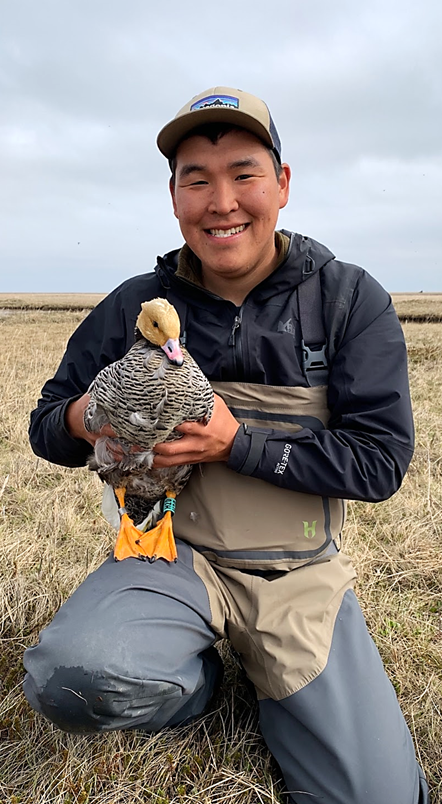BLaST March 2022 Scientist of Month: Paul Larson

Paul Larson holds a spectacled eider duck.
Larson is a second-year BLaST Scholar and holds an officer title in UAF’s Wildlife
Society student chapter. He was raised in Napaskiak, Alaska, and is a first-generation
college student planning to graduate in April 2022. He is interested in waterfowl,
ecology and population dynamics, and hopes to pursue waterfowl research in graduate
school. Larson plans to return to the Yukon Delta to give back to his area’s communities
through research and management of key migratory species for their subsistence and
ecological importance.
Larson’s research interests lie in waterfowl ecology, population dynamics and physiology.
He is also interested in the potential impacts of climate change, contaminants, and
human factors on waterfowl species. Under the guidance of former BLaST research, advising
and mentoring professional Andrew Cyr and the U.S. Fish and Wildlife Service, Larson
was able to examine contaminants in common eiders and the Pb levels using published
studies. Pb is a clean-burning single-base powder commonly used in 12-gauge and 20-gauge
shotshells in rural Alaska and contiguous US.
Larson collected spectacled eider eggshell membranes at Kigigak Island on the Yukon
Delta to determine nutrient sources used to make eggs. He is analyzing the stable
isotope levels of invertebrates as a reference in the Alaska Stable Isotope Facility
Lab.
“Furthering my education will have an impact on research activities and decision-making
as a wildlife biologist. Having research experience is helping me get the skillset
and experience to get one step closer towards my career goal of becoming a scientist.
Being a BLaST Scholar has opened a new world of possibilities for me while continuing
to improve my skills and the experience needed to be a successful researcher.”
This spring, Larson will present at the Midnight Sun Science Symposium and the Undergraduate
Research and Scholarly Activity (URSA) Research days at UAF in April, and attend the
Experimental Biology conference in Philadelphia, PA.
Larson would like to thank his BLaST RAMP, Dr. Andrew Cyr; Dr. Daniel Rizzolo, Micah
Miller, and Claire Montgomery at USFWS; and UAF faculty Drs. Diane O’Brien and Matthew
Wooller, and many others in the ASIF Lab, and at the Alaska Department of Fish & Game,
who supported him and contributed to his research journey.
Larson shared, “Dr. Cyr and Claire with USFWS enhanced my knowledge in contaminants
monitoring with an ecological perspective. Drs Rizzolo, O’Brien, and Wooller contributed
to the stable isotope research in Spectacled Eiders energy production of eggs that
helped me understand the data in the ecological and physiological sense.” Larson said,
“I am fortunate to have awesome mentors who have engaged to help organize my research
project. Together as a team, we planned and networked to bring home a project that
really matters to me.”
These articles are shared across all University of Alaska Fairbanks and University
of Alaska Southeast rural campuses and with BLaST’s partners: Iļisaġvik College, Fort
Lewis College, Diné College, Salish Kootenai College, and Alaska Pacific University.
For more BLaST Scientist of the Month highlights, click onto their website.
For more information about this article, please contact BLaST staff Amy Topkok at aktopkok@alaska.edu.


